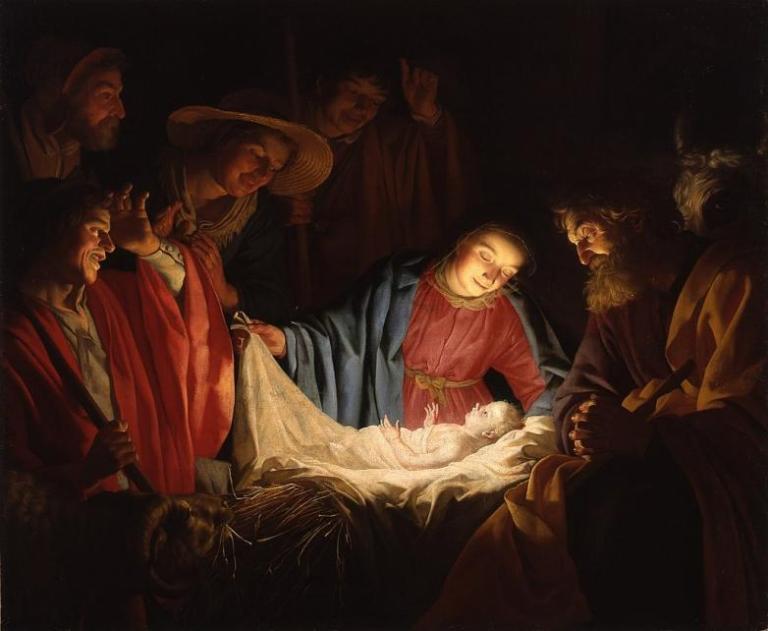There are people who profess to be Christians who nevertheless don’t believe that Jesus was conceived “by the Holy Spirit of the virgin Mary” without a human father. But the notion that this teaching is a mythological accretion or a misunderstanding of the language is being shot down. The virgin birth of Jesus is best explained as a historical fact.
My fellow Patheos blogger Tom Hobson (Ph.D., Concordia Seminary), a Presbyterian pastor and former professor, makes this point in his blog Biblical Words and World. (I commend to you that blog, which explores the historical contexts of Scripture. His New Year’s day post on the Roman calendar fixation, alluded to in Galatians 4:10, tosses off the observation that this year, in 2018, Ash Wednesday falls on Valentine’s Day and Easter coincides with April Fool’s Day!)
Since this is still Christmas and will be until Saturday, which is Epiphany, it’s good to consider Dr. Hobson’s post Logical Grounds for the Virgin Birth.
Drawing on various scholarly sources, he points out that there is really no precedent in the Jewish, Greco-Roman, or Middle Eastern traditions for a virgin birth. It would be off for anyone in those cultures to make up such a thing. Some have claimed that the teaching is “mythological,” pointing to myths of deities impregnating mortal women. But those are stories of human-like beings having sexual relations with humans, so they are far from being depictions of virgin births.
Dr. Hobson also points out that very, very early opponents of Christianity were saying that Jesus had been an illegitimate child, which is evidence that accounts of the unusual circumstances of Jesus’ birth were circulating at a quite early date and that the virgin birth is not the product of a long forming “tradition” as some have said.
There are more reasons to believe in the virgin birth as well, including, of course, the theological reasons. Read Dr. Hobson’s post.
I remember the controversies around the Revised Standard Version of the Bible came out, a modernization of the King James Bible that availed itself of the results of the latest higher critical Biblical scholarship. That version translated Isaiah 7:14 (“a virgin shall conceive, and bear a son”) as “a young woman shall conceive and bear a son.” The reasoning is that the Hebrew word “alma” is just the word for “young woman.”
Now there is certainly other Biblical reasons for confessing the virgin birth than the words of that prophecy, particularly the detailed narrative in the Gospel of Luke. And Matthew 1:23 says that the birth of Jesus fulfills the words of Isaiah 7:14, whereupon he quotes from the Septuagint, the Greek translation of the Hebrew, which renders “alma” with “parthenos,” which definitely means “virgin.”
But in a separate post, Dr. Hobson shows that “alma” can indeed mean “virgin.”
This is taken up in depth by Daniel Hoffman in Is “Virgin” the Correct Translation of Isaiah 7:14? — Knowing Scripture. He does a thorough job of dealing with the linguistic evidence that “alma” had the connotations of virginity. (It would seem that the Jewish scholars who translated the Septuagint knew their language better than some modern higher critics do.)
He then takes up an issue that had always puzzled me. The context of Isaiah 7:14 has to do with King Ahaz, who is faced with a military threat from both Syria and the northern kingdom of Israel, both of whom have allied with Assyria and are putting the southern kingdom of Judah in jeopardy. In a show of false piety, King Ahaz declines to ask God for a sign, but Isaiah says that God will give him a sign anyway: “A virgin shall conceive a child. . . .” And before that child can tell right from wrong, these threatening kings will be no more. So the passage sounds like it refers to a child being born contemporary to Ahaz.
Daniel Hoffman points out that “a young woman” bearing a child happens all the time and would not be much of a sign, certainly not one “deep as Sheol” as the Lord offered. Also, the “you” in the prophecy is plural, so it applies not just to Ahaz but to others as well, he says to the entire royal house. Also, the kingdoms of Syria, Israel, and Assyria ended long after Ahaz’s lifetime.
Furthermore, just two chapters later, we see the prophecy about the child who will be called, “Wonderful, Counselor, the Mighty God, the Everlasting Father, the Prince of Peace” (Isaiah 9:7).
The prophecy does apply to King Ahaz, whose unrighteousness helps bring on the fall of the House of David as Judah’s royal rulers, even though the Messiah will be born from “the stump of Jesse” (Isaiah 11:1). Concludes Hoffman,
Ahaz and his house would have no royal power when this sign came to fulfillment. Because of Ahaz’s capitulation to Assyria, Judah would become a puppet-state and hardly ever again be a fully independent power, but would be subject to foreign empires in one way or another even until the time of Christ. As Motyer puts it, “Because of [Ahaz’s] unbelief the promised Messiah would be born into poverty, heir to a meaningless throne in a conquered land.” In this regard, the sign of the virgin birth functions partly as a word of judgment: Immanuel would have no human father, and thus Ahaz and his successors would not father the royal Savior in a physical sense. The virgin birth implies a broader judgment than this though: It is a judgment on human nature. Not human nature as such or as created, but simply on human nature as corrupt in Adam. The rebuke on Ahaz is thus ultimately turned into a blessing, as the child born of the virgin would mean the birth of a new Adam, ultimately saving not only Israel but offering a fresh start to the whole of humanity.
Painting by Gerard van Honthorst (1622) [Public domain], via Wikimedia Commons














